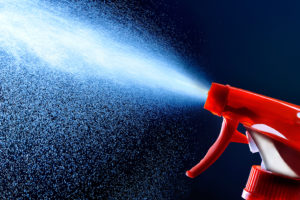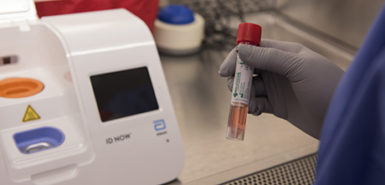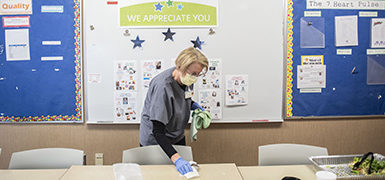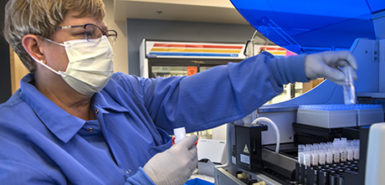
There’s a lot of emphasis on proper hand-washing techniques these days.
Twenty seconds, soap and water. Thorough washing between fingers, under nails, backs of hands.
Simple enough.
But before the heightened public health message emerged a few weeks back, what did your typical hand-washing episode really look like? Maybe 5 to 10 seconds under the faucet, with a dollop of soap?
Among its many effects, a pandemic has forced us to re-evaluate routine habits, challenging fundamental notions about cleanliness, social interaction and personal self-care.
There’s yet another area that could use a bit of scrutiny: disinfecting surfaces.
The Centers for Disease Control and Prevention makes some important distinctions between cleaning, disinfecting and sanitizing.
Sanitizing lowers the number of germs or viruses to a safer level, but it doesn’t eradicate them.
If you’re looking to kill the virus that causes COVID-19—eliminate it from your kitchen countertops, touchpoints, steering wheel, whatever—you’re ideally aiming to clean, disinfect and then clean again.
You can use household bleach—1/3 cup per gallon of water—or a 70% alcohol solution. (There’s plenty of research on use of alcohol and bleach in cleaning and disinfecting.)
“Most common disinfectants are effective against the COVID-19 virus, including those containing bleach, alcohol, chlorine compounds, phenols, hydrogen peroxide and quaternary ammonium,” said Adam Caulfield, PhD, director of microbiology with Spectrum Health.
The EPA has a list of specialized cleaning agents deemed effective against the virus that causes COVID-19. The bulk of them are name brand products you’re familiar with.
But it’s not as simple as spraying and wiping.
“The manufacturer includes a contact time—the amount of time a surface must remain saturated with the disinfectant to reliably kill all bacteria and viruses present,” Dr. Caulfield said. “This time is typically mentioned on a product’s label—and it’s often longer than many people realize.”
It’s important to read the instructions on the product you’re using. The listed contact time allows the product to kill viruses and bacteria.
How much time? As it applies to some viruses, anywhere from 3 to 10 minutes.
Consider one popular brand: Lysol. (Here’s a list of the Lysol products deemed effective against the virus that causes COVID-19.)
To disinfect a surface, the Lysol instructions read, “Surfaces must remain wet for 3 minutes, then allow to air dry.”
To kill norovirus, hepatitis A virus, adenovirus 2, fusarium solani and mycobacterium bovis BCG, the surface must remain wet for 10 minutes, then allowed to air dry.
So if you’ve been spraying and wiping clean, you’ll want to reconsider that process. You also need to spray enough material to keep the surface wet for the recommended duration.
The CDC recommends using detergent or soap and water to clean a dirty surface before you disinfect it. After you’ve cleaned and disinfected the surface and allowed it to dry, you can use a water wipe to remove any residual chemical, Dr. Caulfield said.
Researchers have learned the virus that causes COVID-19 can survive for up to 72 hours on plastic and stainless steel surfaces and up to 24 hours on cardboard.
In targeting areas to disinfect, focus your efforts on frequently touched surfaces such as tables, doorknobs, countertops, light switches, handles, phones and faucets.

 /a>
/a>
 /a>
/a>
 /a>
/a>
Why not use Ozone gas to sterilize surfaces of all types. a couple of studies are available when SARS showed up in 2003-2008. Ozone can be used to sterilize shoes, PPE, clothing, the inside of cars, emergency vehicles, etc. Note that Hydrogen Peroxide gas or liquid can not kill Covid 19 as stated in your article above. Tony
Maybe I’m wrong, but we should also be careful how we use the disinfectants. Yes, they kill germs, virus’s, etc, but we need to be careful “breathing in” the chemicals into our lungs.
Plus what would also be good to know is, “how long are the disinfectants good for?
jv
Hi John, We agree it is important to have good ventilation when spraying chemicals so as to avoid lung exposure. In regard to how long the disinfectants last, are you talking about shelf life of bottles sitting in your cupboard? Or are you asking how long the surfaces remain disinfected? Because, if it’s the latter, then the surface or item is disinfected until such a time as the cleaner dries and the surface become contaminated with new germs. So it’s more of – in that moment, it’s disinfected. If you’re asking about the shelf life of cleaning supplies, it is recommended they be kept in a cool, dry location, and there is a phone number on the side of each container you may call to learn more about their use and longevity. Hope this helps.
Mr. Foucher,
Very good article and many of your comments are factual but I must question your claims on disinfectants effective against Covid-19. There are no EPA claims on disinfectants for Covid-19 I’m aware of, the virus is too new for EPA to register products as tested against Covid-19, only Covid SARS, Corona Virus. Feel free to contact me if you have questions. Thank you.
Great article overall, but I believe I see two minor errors in the text: “you’re ideally aiming to disinfect and then clean.” shouldn’t that be the other way round? Also: I’m pretty sure “quanternary ammonium” is spelled “quaternary” (I sanitize dishes with that stuff all day at work, and you’d be surprised how many of my fellow employees don’t understand how to use it properly
Thanks, AR. In this case, it is actually clean then disinfect then clean because you want to leave the spray on the surface, according to label. Then come back and clean the disinfected surfaces to remove the chemical and make surfaces shine. And thanks for the heads up on the quaternary. We fixed it. Appreciate your readership. 🙂